NCERT Exemplar: Life Processes | Science Class 10 PDF Download
Multiple Choice Questions
Q.1. Which of the following statements about the autotrophs is incorrect?
(a) They synthesise carbohydrates from carbon dioxide and water in the presence of sunlight and chlorophyll
(b) They store carbohydrates in the form of starch
(c) They convert carbon dioxide and water into carbohydrates in the absence of sunlight
(d) They constitute the first trophic level in food chains
Ans: (c)
Q.2. In which of the following groups of organisms, food material is broken down outside the body and absorbed?
(a) Mushroom, green plants, Amoeba
(b) Yeast, mushroom, bread mould
(c) Paramecium, Amoeba, Cuscuta
(d) Cuscuta, lice, tapeworm
Ans: (b)
Q.3. Select the correct statement
(a) Heterotrophs do not synthesise their own food
(b) Heterotrophs utilise solar energy for photosynthesis
(c) Heterotrophs synthesise their own food
(d) Heterotrophs are capable of converting carbon dioxide and water into carbohydrates
Ans: (a)
Q.4. Which is the correct sequence of parts in human alimentary canal?
(a) Mouth → stomach → small intestine → oesophagus → large intestine
(b) Mouth →oesophagus → stomach → large intestine → small intestine
(c) Mouth → stomach → oesophagus → small intestine → large intestine
(d) Mouth → oesophagus → stomach → small intestine → large intestine
Ans: (d)
Q.5. If salivary amylase is lacking in the saliva, which of the following events in the mouth cavity will be affected?
(a) Proteins breaking down into amino acids
(b) Starch breaking down into sugars
(c) Fats breaking down into fatty acids and glycerol
(d) Absorption of vitamins
Ans: (b)
Q.6. The inner lining of stomach is protected by one of the following from hydrochloric acid. Choose the correct one
(a) Pepsin
(b) Mucus
(c) Salivary amylase
(d) Bile
Ans: (b)
Q.7. Which part of alimentary canal receives bile from the liver?
(a) Stomach
(b) Small intestine
(c) Large intestine
(d) Oesophagus
Ans: (b)
Q.8. A few drops of iodine solution were added to rice water. The solution turned blue-black in colour. This indicates that rice water contains
(a) complex proteins
(b) simple proteins
(c) fats
(d) starch
Ans: (d)
Q.9. In which part of the alimentary canal food is finally digested?
(a) Stomach
(b) Mouth cavity
(c) Large intestine
(d) Small intestine
Ans: (d)
Q.10. Choose the function of the pancreatic juice from the following
(a) trypsin digests proteins and lipase carbohydrates
(b) trypsin digests emulsified fats and lipase proteins
(c) trypsin and lipase digest fats
(d) trypsin digests proteins and lipase emulsified fats
Ans: (d)
Q.11. When air is blown from mouth into a test-tube containing lime water, the lime water turned milky due to the presence of
(a) oxygen
(b) carbon dioxide
(c) nitrogen
(d) water vapour
Ans: (b)
Q.12. The correct sequence of anaerobic reactions in yeast is
(a) 
(b) 
(c) 
(d) 
Ans: (d)
Q.13. Which of the following is most appropriate for aerobic respiration?
(a) 
(b) 
(c) 
(d) 
Ans: (d)
Q.14. Which of the following statement(s) is (are) true about respiration?
(i) During inhalation, ribs move inward and diaphragm is raised
(ii) In the alveoli, exchange of gases takes place i.e., oxygen from alveolar air diffuses into blood and carbon dioxide from blood into alveolar air
(iii) Haemoglobin has greater affinity for carbon dioxide than oxygen
(iv) Alveoli increase surface area for exchange of gases
Choose the correct option:
(a) (i) and (iv)
(b) (ii) and (iii)
(c) (i) and (iii)
(d) (ii) and (iv)
Ans: (d)
Q.15. Which is the correct sequence of air passage during inhalation?
(a) Nostrils → larynx → pharynx → trachea → lungs
(b) Nasal passage → trachea → pharynx → larynx → alveoli
(c) larynx → nostrils → pharynx → lungs
(d) Nostrils → pharynx → larynx → trachea → alveoli
Ans: (d)
Q.16. During respiration exchange of gases take place in
(a) trachea and larynx
(b) alveoli of lungs
(c) alveoli and throat
(d) throat and larynx
Ans: (b)
Q.17. Which of the following statement (s) is (are) true about heart?
(i) Left atrium receives oxygenated blood from different parts of body while right atrium receives deoxygenated blood from lungs
(ii) Left ventricle pumps oxygenated blood to different body parts while right ventricle pumps deoxygenated blood to lungs
(iii) Left atrium transfers oxygenated blood to right ventricle which sends it to different body parts
(iv) Right atrium receives deoxygenated blood from different parts of the body while left ventricle pumps oxygenated blood to different parts of the body
Choose the correct option:
(a) (i)
(b) (ii)
(c) (ii) and (iv)
(d) (i) and (iii)
Ans: (c)
Q.18. What prevents backflow of blood inside the heart during contraction?
(a) Valves in heart
(b) Thick muscular walls of ventricles
(c) Thin walls of atria
(d) All of the above
Ans: (a)
Q.19. Single circulation i.e., blood flows through the heart only once during one cycle of passage through the body, is exhibited by
(a) Labeo, Chameleon, Salamander
(b) Hippocampus, Exocoetus, Anabas
(c) Hyla, Rana, Draco
(d) Whale, Dolphin, Turtle
Ans: . (b)
Q.20. In which of the following vertebrate group/groups, heart does not pump oxygenated blood to different parts of the body?
(a) Pisces and amphibians
(b) Amphibians and reptiles
(c) Amphibians only
(d) Pisces only
Ans: (d)
Q.21. Choose the correct statement that describes arteries.
(a) They have thick elastic walls, blood flows under high pressure; collect blood from different organs and bring it back to the heart
(b) They have thin walls with valves inside, blood flows under low pressure and carry blood away from the heart to various organs of the body
(c) They have thick elastic walls, blood flows under low pressure; carry blood from the heart to various organs of the body
(d) They have thick elastic walls without valves inside, blood flows under high pressure and carry blood away from the heart to different parts of the body.
Ans: (d)
Q.22. The filtration units of kidneys are called
(a) ureter
(b) urethra
(c) neurons
(d) nephrons
Ans: (d)
Q.23. Oxygen liberated during photosynthesis comes from
(a) water
(b) chlorophyll
(c) carbon dioxide
(d) glucose
Ans: (a)
Q.24. The blood leaving the tissues becomes richer in
(a) carbon dioxide
(b) water
(c) heamoglobin
(d) oxygen
Ans: (a)
Q.25. Which of the following is an incorrect statement?
(a) Organisms grow with time
(b) Organisms must repair and maintain their structure
(c) Movement of molecules does not take place among cells
(d) Energy is essential for life processes
Ans: (c)
Q.26. The internal (cellular) energy reserve in autotrophs is
(a) glycogen
(b) protein
(c) starch
(d) fatty acid
Ans: (c)
Q.27. Which of the following equations is the summary of photosynthesis?
(a) 6CO2 + 12H2O → C6H12O6 + 6O2+ 6H2O
(b) 6CO2 + H2O + Sunlight→ C6H12O6 + O2 + 6H2O
(c) 6CO2 + 12H2O + Chlorophyll + Sunlight→ C6H12O6 + 6O2 + 6H2O
(d) 6CO2 + 12H2O + Chlorophyll + Sunlight→ C6H12O6 + 6CO2 + 6H2O
Ans: (c)
Q.28. Choose the event that does not occur in photosynthesis
(a) Absorption of light energy by chlorophyll
(b) Reduction of carbon dioxide to carbohydrates
(c) Oxidation of carbon to carbon dioxide
(d) Conversion of light energy to chemical energy
Ans: (c)
Q.29. The opening and closing of the stomatal pore depends upon
(a) oxygen
(b) temperature
(c) water in guard cells
(d) concentration of CO2 in stomata
Ans: (c)
Q.30. Choose the forms in which most plants absorb nitrogen
(i) Proteins
(ii) Nitrates and Nitrites
(iii) Urea
(iv) Atmospheric nitrogen
Choose the correct option:
(a) (i) and (ii)
(b) (ii) and (iii)
(c) (iii) and (iv)
(d) (i) and (iv)
Ans: (b)
Q.31. Which is the first enzyme to mix with food in the digestive tract?
(a) Pepsin
(b) Cellulase
(c) Amylase
(d) Trypsin
Ans: (c)
Q.32. Which of the following statement(s) is (are) correct?
(i) Pyruvate can be converted into ethanol and carbon dioxide by yeast
(ii) Fermentation takes place in aerobic bacteria
(iii) Fermentation takes place in mitochondria
(iv) Fermentation is a form of anaerobic respiration
Choose the correct option:
(a) (i) and (iii)
(b) (ii) and (iv)
(c) (i) and (iv)
(d) (ii) and (iii)
Ans: (c)
Q.33. Lack of oxygen in muscles often leads to cramps among cricketers. This results due to
(a) conversion of pyruvate to ethanol
(b) conversion of pyruvate to glucose
(c) non conversion of glucose to pyruvate
(d) conversion of pyruvate to lactic acid
Ans: (d)
Q.34. Choose the correct path of urine in our body
(a) kidney → ureter → urethra → urinary bladder
(b) kidney → urinary bladder → urethra → ureter
(c) kidney → ureters → urinary bladder → urethra
(d) urinary bladder → kidney → ureter → urethra
Ans: (c)
Q.35. During deficiency of oxygen in tissues of human beings, pyruvic acid is converted into lactic acid in the
(a) cytoplasm
(b) chloroplast
(c) mitochondria
(d) golgi body
Ans: (a)
Short Answer Type Questions
Q.36. Name the following:
(a) The process in plants that links light energy with chemical energy.
(b) Organism that can prepare their own food.
(c) The cell organelle where photosynthesis occurs.
(d) Cells that surround a stomatal pore.
(e) Organisms that cannot prepare their own food.
(f) An enzyme secreted from gastric glands in stomach thact acts on proteins.
Ans: (a) Photosynthesis
(b) Autotrophs
(c) Chloroplasts
(d) Guard cells
(e) Heterotrophs
(f) Pepsin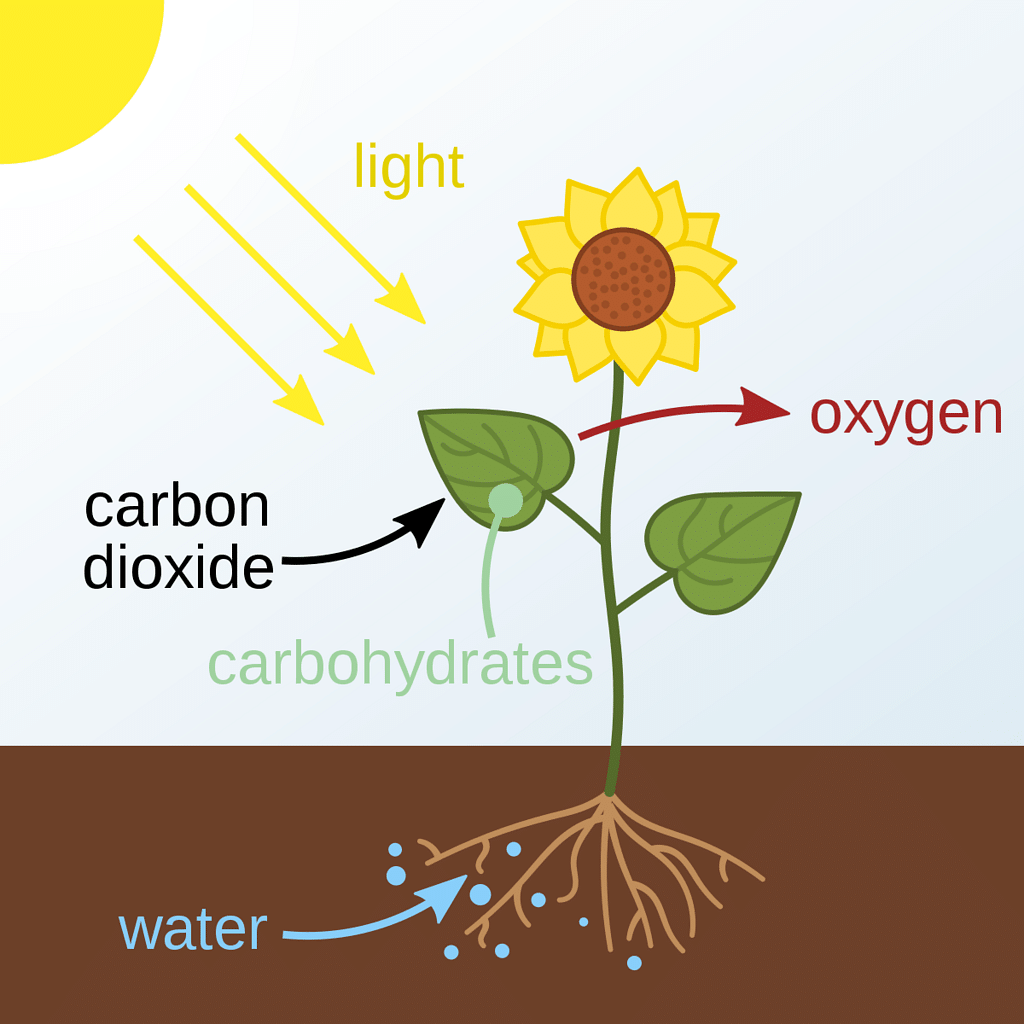 Q.37. “All plants give out oxygen during day and carbon dioxide during night”. Do yo agree with this statement? Give reason.
Q.37. “All plants give out oxygen during day and carbon dioxide during night”. Do yo agree with this statement? Give reason.
Ans: Yes, respiration takes place throughout day and night but photosynthesis occurs only during the day. During daytime, plants give out oxygen which is a product of photosynthesis. Thus, during night when there is no photosynthesis, plants liberate carbon dioxide.
Q.38. How do the guard cells regulate opening and closing of stomatal pores?
Ans: The swelling of guard cells due to absorption of water causes opening of stomatal pores while shrinking of guard cells closes the pores. Opening and closing of stomata occurs due to turgor changes in guard cells. When guard cells are turgid, stomatal pore is open while in flaccid conditions, the stomatal aperture closes.
Q.39. Two green plants are kept separately in oxygen free containers. One in dark and other in continuous light which one will longer? Give reasons.
Ans: The plant which kept in continuous light will live longer because in light, the plant will be able to undergo photosynthesis and able to convert carbon dioxide into oxygen whereas the plant in dark cannot perform photosynthesis and lack of oxygen will kill the plant.
Q.40. If a plant is releasing carbon dioxide and taking in oxygen during the day, does it mean that there is no photosynthesis occurring? Justify your answer.
Ans: Release of CO2 and intake of O2 gives evidence that either photosynthesis is not taking place or its rate is too low. Normally during day time, the rate of photosynthesis is much more than the rate of respiration. So, CO2 produced during respiration is used up for photosynthesis hence CO2 is not released.
Q 41. Why do fishes die when taken out of water?
Ans: Fishes die when taken out of water because they cannot obtain gaseous oxygen.
They breath through gills, which are richly supplied with blood capillaries and can readily absorb oxygen dissolved in water.
Q.42. Differentiate between an autotroph and a heterotroph.
Ans:
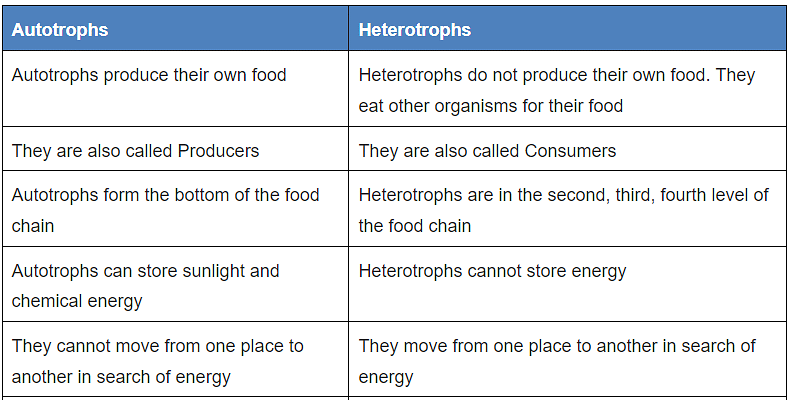
Q.43. Is ‘nutrition’ a necessity for an organism? Discuss.
Ans. Yes, ‘nutrition’ is a necessity for an organism because:
- It is required for the growth of new cells and repair of worn out cells.
- It is required to develop resistance against various diseases.
- It gives us energy for various metabolic activities of our body.
Q.44. What would happen if green plants disappear from the earth?
Ans: If green plants disappear from the earth, then the herbivores will die of starvation followed by carnivores and then decomposers.
Q.45. Leaves of a healthy potted plant were coated with vaseline will this plant remain healthy for long? Give reasons for your answer.
Ans:
- The plant will die soon because layer of vaseline will prevent the exchange of gases for respiration.
- It will also close the stomatal openings and plant won’t be able to get the necessary raw materials for photosynthesis.
Q.46. How does aerobic respiration differ from anaerobic respiration?
Ans:

Q.47. Match the words of Column (A) with that of Column (B)
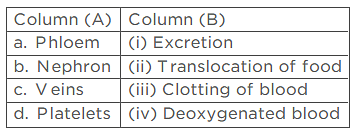
Ans: (a) Phloem - (ii) Translocation of food
(b) Nephron - (i) Excretion
(c) Veins - (iv) Deoxygenated blood
(d) Platelets - (iii) Clotting of blood
Q.48. Differentiate between an artery and a vein.
Ans:
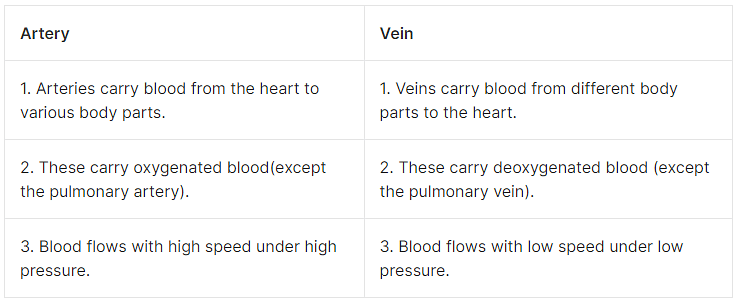
Q.49. What are the adaptations of leaf for photosynthesis?
Ans: The adaptations of leaf for photosynthesis are as follows:
- Leaf has a large surface area to absorb maximum light.
- Arrangement of leaves in order to absorb the optimum amount of light.
- A large number of veins provide mechanical strength and also take part in the quick transport of substances to and from the mesophyll cells.
- The leaf is the site of transpiration which cools the leaf surface for optimum photosynthesis.
- Leaf has numerous stomata for gaseous exchange.
- A large number of chloroplasts are present on the upper surface of leaves.
Q.50. Why is the small intestine in herbivores longer than in carnivores?
Ans: Herbivores eat grass and need a longer small intestine to allow complete digestion of cellulose. But carnivores cannot digest cellulose, and therefore they have a shorter intestine.
Q.51. What will happen if the mucus is not secreted by the gastric glands?
Ans: If the mucus is not secreted by the gastric glands, it will lead to corrosion of the inner lining of the stomach, causing excessive acidity, ulcers, and extreme discomfort as mucus protects the inner lining of the stomach from the action of hydrochloric add and enzyme pepsin.
Q.52. What is the significance of emulsification of fats?
Ans: Fats are present in food in the form of large globules which makes it difficult for enzymes to act on them. Bile salts present in bile break them down mechanically into smaller globules which increases the efficiency of fat digesting enzymes.
Q.53. What causes movement of food inside the alimentary canal?
Ans: The wall of alimentary canal contains muscle layers. Rhythmic contraction and relaxation of these muscles pushes the food forward. This is called peristalsis, which occurs all along the gut.
Q.54. Why does absorption of digested food occur mainly in the small intestine?
Ans: Absorption of digested food occurs mainly in the small intestine because:
(i) Digestion of food is completed in the small intestine.
(ii) Inner lining of the small intestine bears a number of finger-like projections called villi, which increases the surface area for absorption.
(iii) Wall of the intestine has blood vessels for carrying the absorbed food to different parts of the body.
Q.55. Match Group (A) with Group (B)

Ans: (a) Autotrophic nutrition- (iv) Green plant
(b) Heterotrophic nutrition - (iii) Deer
(c) Parasitic nutrition - (i) Leech
(d) Digestion in food vacuoles - (ii) Paramoecium
Q.56. Why is the rate of breathing in aquatic organisms much faster than in terrestrial organisms?
Ans: The rate of breathing in aquatic organisms is much faster than in terrestrial organisms because the amount of dissolved oxygen in water is low as compared to the amount of oxygen in the air. Aquatic animals take in water through their mouths and past it to the gills where the dissolved oxygen is taken up by the blood.
Q.57. Why is blood circulation in human heart called double circulation?
Ans: The blood circulation in human heart is called double circulation because the blood passes through the heart twice in one complete cycle of the body – once through the right half in the form of deoxygenated blood and once through the left half in the form of oxygenated blood.
Q.58. What is the advantage of having a four-chambered heart?
Ans: The advantage of having a four-chambered heart is that it prevents oxygenated and deoxygenated blood from mixing, as the left half of the four-chambered heart is completely separated from the right half by septa. This mechanism is useful to animals with high energy needs such as birds and mammals. In this way, a highly efficient supply of oxygenated blood is passed to all parts of the body.
Q.59. Mention the major events during photosynthesis
Ans: The major events during photosynthesis are
(a) absorption of light energy by chlorophyll
(b) conversion of light energy to chemical energy
(c) splitting of H2O into H2, O2 and e–
(d) reduction of CO2 to carbohydrates
Q.60. In each of the following situations what happens to the rate of photosynthesis?
(a) Cloudy days
(b) No rainfall in the area
(c) Good manuring in the area
(d) Stomata gets blocked due to dust.
Ans: (a) On cloudy days, photosynthesis is reduced due to low light intensity.
(b) In case of no rainfall in the area, rate of photosynthesis decreases.
(c) With good manuring in the area, rate of photosynthesis increases, it increases soil fertility.
(d) When stomata gets blocked due to dust, photosynthesis decreases by reducing gaseous exchange.
Q.61. Name the energy currency in the living organisms. When and where is it produced?
Ans: Adenosine triphosphate (ATP) is the energy currency of the living organisms. It is produced during respiration in living organisms and also during photosynthesis in plants.
Q.62. What is common for cuscuta, ticks and leeches?
Ans: All are parasites and they derive their nutrition from their hosts directly without killing them.
Q.63. Explain the role of mouth in digestion of food.
Ans: (a) Food is crushed into small pieces by the teeth.
(b) It mixes with saliva and the enzyme amylase (found in saliva) breaks down starch into sugars
(c) Tongue helps in thorough mixing of food with saliva.
Q.64. What are the functions of gastric glands present in the wall of the stomach?
Ans: Functions of the gastric glands present in the wall of the stomach are as follows:
(i) Secretion of mucus for protection of inner lining of stomach.
(ii) Secretion of HCI which makes the food soft and acidified for pepsin to act upon food.
(iii) Secretion of pepsin enzyme that digests proteins.
Q.65. Match the terms in Column (A) with those in Column (B)
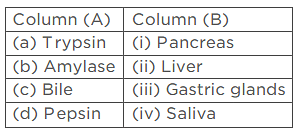
Ans: (a) Trypsin - (i) Pancreas
(b) Amylase- (iv) Saliva
(c) Bile - (ii) Liver
(d) Pepsin- (iii) Gastric glands
Q.66. Name the correct substrates for the following enzymes
(a) Trypsin
(b) Amylase
(c) Pepsin
(d) Lipase
Ans: (a) Trypsin - Protein
(b) Amylase - starch
(c) Pepsin -Protein
(d) Lipase - Fat
Q.67. Why do veins have thin walls as compared to arteries?
Ans: Arteries carry blood from the heart to various organs of the body under high pressure so they have thick and elastic walls. Veins collect the blood from different organs and bring it back to the heart. The blood is no longer under pressure so the walls are thin with valves to ensure that blood flows only in one direction.
Q.68. What will happen if platelets were absent in the blood?
Ans: In the absence of platelets, the process of clotting will be affected.
Q.69. Plants have low energy needs as compared to animals. Explain.
Ans: Plants have low energy needs as compared to animals because plants do not move and most of their body is made up of dead cells like sclerenchyma. But animals move about in search of food, mate and shelter.
Q.70. Why and how does water enter continuously into the root xylem?
Ans: Cells of root are in close contact with soil and so actively take up ions. Ions pass inward increasing osmotic concentration of xylem. Because of it water from the soil continuously pass into the root xylem.
Q.71. Why is transpiration important for plants?
Ans: Transpiration is important because
(a) it helps in absorption and upward movement of water and minerals from roots to leaves
(b) it prevents the plant parts from heating up.
Q.72. How do leaves of plants help in excretion?
Ans:
- In leaves, the waste materials are stored in the vacuoles of mesophyll and epidermal cells. When old leaves fall, the waste materials are excreted along with the leaves.
- Transpiration of gases via stomata helps in removal of gaseous waste of respiration and photosynthesis.
Long Answer Type Questions
Q.73. Explain the process of nutrition in Amoeba.
Ans: Amoeba shows holozoic nutrition which Is comprised of the following steps: Ingestion, Digestion, Absorption. Assimilation and Egestion.
- Ingestion: Amoeba makes fingerlike projections called pseudopodia. Amoeba traps food particles with the help of pseudopodia. After that, Amoeba takes in the food particle along with water.
- Digestion: Amoeba makes food vacuole after ingesting the food particle. Enzymes are released in the food vacuole for digestion.
- Absorption: After digestion, nutrients enter the cytoplasm through osmosis. Assimilation: Nutrients are utilized by the cell for various purposes.
- Egestion: Food vacuole goes near the cell membrane to empty its contents outside the cell. This results in the expulsion of waste materials from the cell.
Q.74. Describe the alimentary canal of man.
Ans: Alimentary canal in man is 9 meters long and consists of the following parts:
- Mouth: It leads into the buccal cavity. The floor of the buccal cavity has tongue-bearing taste buds. Man possesses teeth on both jaws.
There are 32 teeth of four different types: incisors, canines, premolars, and molars. - Pharynx: It is a short, conical region that lies after the mouth cavity.
- Oesophagus: It is a long, narrow, muscular tube that leads to the stomach.
- Stomach: It lies below the diaphragm on the left side of the abdominal cavity and is J-shaped. The food is stored and partly digested in the stomach.
- Small Intestine: It is a convoluted tube and differentiated into three regions, viz., duodenum, which is the first part of the small intestine and is curved C-shaped; jejunum, comparatively longer and more coiled, and ileum, which is the last part of small intestine whose inner surface is folded to form villi, which absorbs the products of digestion.
- Large Intestine. It is much shorter and wider than small intestine and is differentiated into three regions viz., caecum, which is small rounded blind sac from which vermiform appendix arises; colon is the inverted U-shaped tube and the rectum opens to exterior through anus.
Q.75. Explain the process of breathing in man.
Ans: Breathing involves two step, namely. inhalation and exhalation.
- Inhalation: The process of taking in air is called inhalation. During this process, ribs move forward and upward while the diaphragm contracts to form a dome shape . This increases the volume of the thoracic cavity and reduces the pressure in the lungs. As a result, air moves into the lungs.
- Exhalation: The process of giving out air is called exhalation. During this process, ribs go backwards and downwards while the diaphragm relaxes. This reduces the volume of the thoracic cavity and increases the pressure in lungs. As a result, air moves out of the lungs.
Q.76. Explain the importance of soil for plant growth.
Ans: Importance of soil for plant growth:
- It anchors the plant.
- It is the source of water and minerals.
- It helps in symbiotic association with microbes.
- It helps for respiration of root cells due to availability of oxygen of food material.
Q.77. Draw the diagram of alimentary canal of man and label the following parts.
Mouth, Oesophagus, Stomach, Intestine
Ans:

Q.78. How do carbohydrates, proteins and fats get digested in human beings?
Ans:
- Digestion of carbohydrates: Digestion of carbohydrates begins from buccal cavity. Salivary amylase converts starch into sugar. Other complex carbohydrates are convened into glucose in the small intestine.
- Digestion of Proteins: Protein is partially digested in the stomach. For this, stomach secretes the enzyme pepsin. In small intestine, pancreatic juice provides the enzymes trypsin and chymotrypsin. These enzymes complete the digestion of proteins.
- Digestion of Fats: Digestion of fats takes place in small intestine. Bile; from liven emulsifies the fat. Due to this, fat is broken into small globules. This makes it easier for the enzyme to digest fat. Lipase is the enzyme which converts fat into glycerol and fatty acid.
Q.79. Explain the mechanism of photosynthesis.
Ans: Photosynthesis is a process in which the light energy obtained from the sunlight is used in the manufacture of oxygen and sugar molecules in the presence of carbon dioxide and water. The mechanism of photosynthesis involves two processes; the light reaction that takes place in the thylakoid membrane that leads to the production of NADPH and ATP. Another important reaction involves the light-independent reaction also known by the name ‘Calvin cycle’ that occurs in the stroma of the chloroplasts which is the final step that produces sugar. The NADP and ATP energy-rich molecules play an important role in light-independent reactions to fix the carbon dioxide in order to synthesize glucose molecules.
Q.80. Explain the three pathways of breakdown in living organisms.
Ans: In all organisms, glucose is first converted into pyruvate. Glucose is a 6-carbon molecule, while pyruvate is a 3-carbon molecule. This step is same in all organisms and it happens in the cytoplasm. Further breakdown of pyruvate can happen in any of the following ways:
- In Yeast: In yeast, breakdown of pyruvate take place in absence of oxygen. Due to this, it is called anaerobic respiration. Pyruvate is broken down into ethanol and carbon dioxide.
- In muscle cells: During strenuous physical activity, the energy demand from muscle cells suddenly increases. This is compensated by anaerobic respiration in muscle cells. In such a situation, pyruvate is broken down into lactic acid.
- In mitochondria: In this case, breakdown of pyruvate takes place in presence of oxygen. Due to this, it is called aerobic respiration. Pyruvate is broken down into carbon dioxide and water. Aerobic respiration is found in most of the living beings.
Q.81. Describe the flow of blood through the heart of human beings.
Ans: Flow of blood through heart:
(a) Deoxygenated blood from different organs comes to the right atrium through the vena cava.
(b) From the right atrium, blood goes to the right ventricle. The tricuspid valve between the right atrium and right ventricle prevents the backflow of blood.
(c) From the right ventricle, blood goes to the lungs through the pulmonary artery. Inside the lungs, carbon dioxide is removed from the blood and oxygen enters the blood.
(d) From the lungs, blood goes to the left atrium through the pulmonary vein.
(e) From the left atrium, blood goes to the left ventricle.
(f) From the left ventricle, blood is pumped into the aorta so that it can be supplied to different organs.
Q.82. Describe the process of urine formation in kidneys.
Ans: Urine is formed in the kidneys in the nephron , i.e., the structural and functional unit of kidney. Blood at high pressure travels into these tubules by the tuft of blood capillaries called glomerulus.
The following steps are involved in the process:
(i) Filtration Blood enters the glomerulus through the afferent arterioles, it passes under pressure that results in filtration of blood . Water and small molecules are forced out of glomerular capillary walls and Bowman's capsule. Large molecules remain in the blood of the glomerulus.
(ii) Selective reabsorption Some molecules are selectively reabsorbed into the blood. The glomerular filtrate flows through the proximal convoluted tubule, the U- shaped Henle's loop and distal convoluted tubule. The useful substances present such as glucose , amino acids and salts are reabsorbed by a process , which requires energy . The filtrate now contains urea, some salts and The water is then resbsorbed into blood by osmosis (osmoregulation).
(iii) Tubular secretion Some nitrogenous waste products like creatinine and some other substances like K+ are removed from blood by DCT (Distal convulated tubule), and are added to urine. The urine formed is collection in the urinary bladder.
|
85 videos|437 docs|75 tests
|
FAQs on NCERT Exemplar: Life Processes - Science Class 10
| 1. What are the life processes in living organisms? |  |
| 2. What is the importance of nutrition in living organisms? |  |
| 3. How do living organisms obtain nutrition? |  |
| 4. What is the significance of respiration in living organisms? |  |
| 5. How do living organisms excrete waste materials? |  |

|
Explore Courses for Class 10 exam
|

|


















